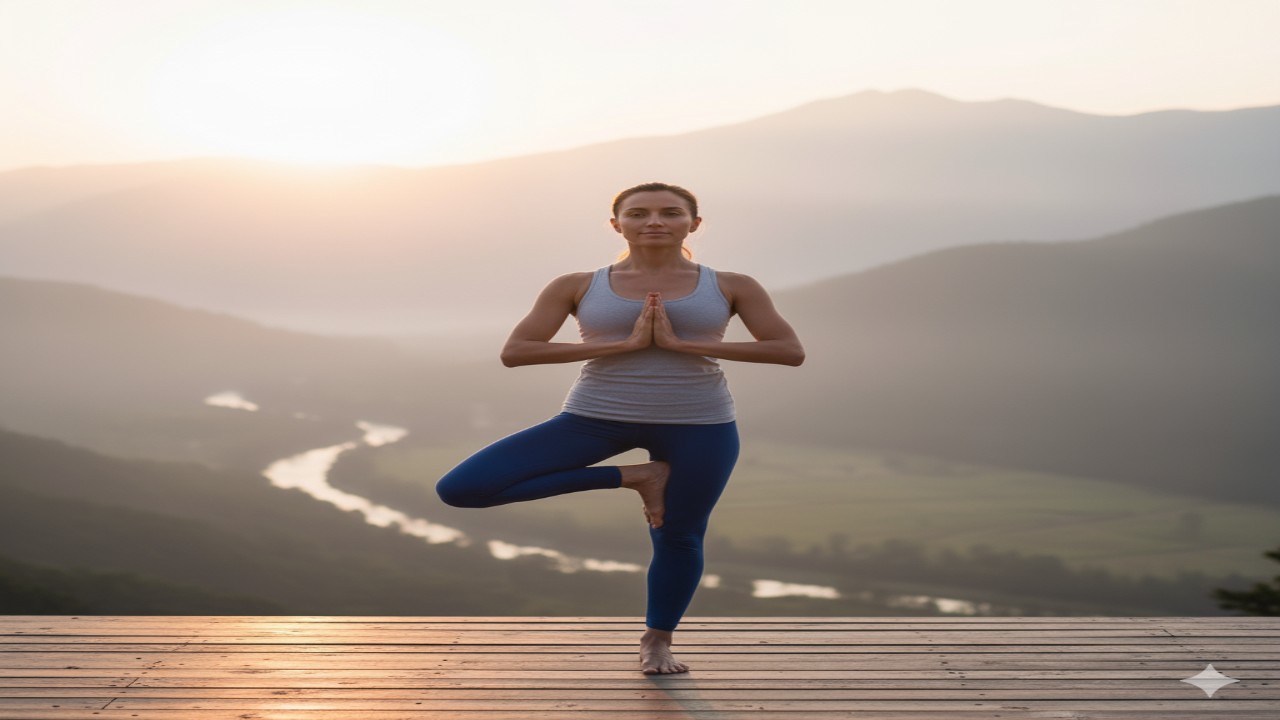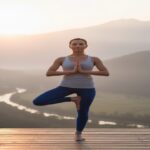In the rich tapestry of yoga asanas, few poses capture the imagination quite like Vrikshasana, or Tree Pose. This elegant balancing posture invites us to stand on one leg, rooting down like a tree while reaching skyward with grace and determination. More than just a test of physical balance, Vrikshasana is a meditation in motion, a practice that teaches us about steadiness, focus, and the beautiful interplay between stability and growth.
Watch a tree standing in the wind—it bends but doesn’t break, sways but never loses its rootedness. It draws nourishment from the earth while reaching toward the sun. These same qualities are what we cultivate when we practice Tree Pose: the ability to remain grounded while aspiring upward, to find stillness amid movement, and to stand firm in the face of life’s inevitable wobbles.
Whether you’re new to yoga or have been practicing for years, Vrikshasana offers valuable lessons that extend far beyond the mat. This comprehensive guide will explore every dimension of Tree Pose, from its physical mechanics and benefits to its deeper philosophical meanings, providing you with the tools to develop a rich and meaningful practice.
What is Vrikshasana?
Vrikshasana derives its name from the Sanskrit words “vriksha” (tree) and “asana” (pose). It is a standing balance pose that requires you to root through one leg while placing the sole of the opposite foot against the inner thigh, calf, or ankle of the standing leg, with arms typically raised overhead or held at the heart center.
Tree Pose is classified as a beginner to intermediate pose, though achieving true stability and grace in the posture can take years of practice. It appears in most styles of yoga and is often included early in sequences to help practitioners develop focus, balance, and body awareness.
What makes Vrikshasana unique among balancing poses is its verticality and openness. Unlike poses where you’re folding forward or extending horizontally, Tree Pose has you standing upright, exposed and vulnerable, yet strong and dignified. This quality makes it both challenging and deeply empowering.
The pose embodies the essence of what a tree represents: growth, stability, connection to the earth, and aspiration toward the light. When practiced with awareness, Vrikshasana becomes more than an exercise—it transforms into a moving meditation on balance, patience, and the nature of stability itself.
The Anatomy of Tree Pose
Understanding the anatomical elements of Vrikshasana helps practitioners refine their alignment and deepen their practice.
The Standing Leg: Your Root System
The standing leg is your foundation, much like a tree’s root system. Every muscle from the foot to the hip must work in harmony to create stability.
The foot of the standing leg spreads wide, with weight distributed evenly across the heel, ball of the foot, and the base of the big and little toes. The arch of the foot lifts actively, preventing collapse inward. The ankle remains strong and aligned, neither rolling in nor out.
The calf and shin muscles engage to stabilize the ankle. The quadriceps activate strongly, lifting the kneecap and providing support without hyperextending the knee. The hamstrings engage moderately, working in concert with the quads to create balanced leg strength.
The hip of the standing leg works to maintain level hips and prevent the pelvis from tilting. Hip abductors and external rotators fire to keep the hip stable and prevent it from jutting out to the side.
The Lifted Leg: Creating the Branch
The bent leg creates the characteristic shape of Tree Pose. The hip of the lifted leg opens externally, rotating the thigh outward to allow the knee to point toward the side.
The foot presses firmly against the standing leg, creating an energetic push-pull relationship. This isn’t passive placement—both legs actively engage with each other. The pressure from the lifted foot is met with equal resistance from the standing leg, creating stability through dynamic tension.
The muscles of the inner thigh (adductors) of the lifted leg work to maintain the position, while the outer hip (abductors) help open the hip and keep the knee pointing outward rather than forward.
Pelvic Alignment and Core Engagement
The pelvis remains level and faces forward. One of the most common misalignments in Tree Pose is allowing the hip of the standing leg to jut out or the pelvis to tilt. The core muscles—particularly the obliques and transverse abdominis—work to maintain pelvic neutrality.
The lower abdomen draws gently in and up, supporting the lower back and creating a stable center from which the upper body can extend. This engagement shouldn’t create rigidity but rather a sense of integrated support.
Spinal Extension and Upper Body
The spine lengthens from the rooted standing leg all the way through the crown of the head. The natural curves of the spine are maintained while creating a sense of upward lift.
The chest remains open, with the heart center lifting slightly. The shoulders roll back and down, creating breadth across the collarbones. The shoulder blades rest naturally on the back without pinching together.
Arm Positions
Arms can be held in various positions depending on the variation being practiced. Whether at the heart center, extended overhead, or in other mudras, the arms remain active yet free of tension. Shoulders stay relaxed away from the ears, and energy extends through the fingertips.
Head and Gaze
The head balances naturally atop the spine, with the chin parallel to the floor. The gaze, or drishti, is crucial for balance. Typically, practitioners fix their gaze on a non-moving point at eye level, about four to six feet in front of them. This steady gaze helps stabilize the mind and, consequently, the body.
Step-by-Step Instructions
Preparing for Tree Pose
Step 1: Begin in Tadasana Start in Mountain Pose at the front of your mat. Take several breaths to ground yourself and establish a firm foundation. Feel the connection of both feet to the earth and find your center of balance.
Step 2: Find Your Drishti Select a fixed point at eye level to focus on throughout the pose. This should be something stationary—a mark on the wall, a piece of furniture, or any non-moving object. Maintain a soft, steady gaze on this point.
Step 3: Shift Your Weight Begin to shift your weight onto your right foot. Feel all four corners of the right foot pressing firmly into the mat. Take your time with this transition—rushing into the balance is often why people wobble.
Step 4: Root Down Engage your right leg fully. Lift the kneecap by engaging the quadriceps, but don’t lock the knee. Feel the strength in your standing leg from foot to hip. Imagine roots growing from your right foot deep into the earth.
Entering the Pose
Step 5: Lift Your Left Foot Bend your left knee and lift your left foot off the ground. Initially, you might place your left foot against your right ankle, with toes still touching the floor for support. This is a valid variation for beginners.
Step 6: Position Your Foot When you feel stable, bring the sole of your left foot to your inner right ankle, calf, or inner thigh. Never place the foot directly on the knee joint, as this can create harmful lateral pressure on the knee.
If placing the foot on the inner thigh, the heel should press into the top of the inner thigh with toes pointing down. Press your foot firmly into your leg and your leg firmly into your foot—this reciprocal pressure creates stability.
Step 7: Open Your Hip Allow your left knee to open out to the side. Your hips should remain level and facing forward, even as the lifted knee points sideways. Engage your core to prevent your pelvis from tilting.
Step 8: Find Your Balance Before moving your arms, take several breaths to stabilize in the lower body. Make micro-adjustments as needed. Balance is dynamic, not static—you’ll naturally make constant tiny corrections.
Step 9: Position Your Arms Bring your hands to your heart center in Anjali Mudra (prayer position). This is the most stable arm position. When you feel ready, you can raise your arms overhead, either keeping palms together, separating them shoulder-width apart, or branching the arms like tree limbs.
Step 10: Lengthen and Breathe Lengthen through your spine from your rooted foot through the crown of your head. Draw your shoulder blades down your back. Take 5-10 deep breaths, or hold as long as you can maintain good form.
Exiting the Pose
Step 11: Release Mindfully Lower your arms back to your heart or to your sides. Slowly and with control, lower your left foot back to the ground, returning to Tadasana.
Step 12: Pause and Observe Stand in Mountain Pose for a few breaths, noticing any differences between the two sides of your body. This observation without judgment is an important part of the practice.
Step 13: Repeat on the Other Side Shift your weight to your left foot and repeat the entire sequence, balancing on your left leg with your right foot lifted.
The Physical Benefits of Vrikshasana
Enhanced Balance and Coordination
Tree Pose is fundamentally a balancing posture, and regular practice significantly improves balance and proprioception. This enhanced sense of where your body is in space translates to better coordination in daily activities and reduced risk of falls, particularly important as we age.
Strengthened Legs and Ankles
The standing leg works intensely in Vrikshasana, strengthening the muscles of the foot, ankle, calf, and thigh. The small stabilizing muscles that are often underworked in regular activities become engaged and strengthened, creating more stable and resilient lower limbs.
Improved Hip Flexibility and Mobility
The external rotation required in the lifted leg gradually opens the hip joint, increasing flexibility in the hip flexors, adductors, and external rotators. This increased hip mobility benefits walking, running, and virtually all movement patterns.
Core Strengthening
Maintaining balance in Tree Pose requires significant core engagement. The deep stabilizing muscles of the abdomen and lower back work throughout the pose to keep the torso upright and the pelvis level, building functional core strength.
Postural Improvement
Vrikshasana reinforces proper spinal alignment and postural awareness. The vertical nature of the pose teaches the body what good posture feels like, making it easier to maintain healthy alignment throughout the day.
Foot Health
The active engagement of the standing foot strengthens the arches and small muscles of the feet. This can help prevent or alleviate flat feet, plantar fasciitis, and other foot-related issues.
Spinal Health
The lengthening through the spine in Tree Pose helps decompress the vertebrae and maintain the spine’s natural curves. This can alleviate back pain and prevent spinal compression that occurs from prolonged sitting.
Improved Circulation
Standing on one leg challenges the circulatory system to work more efficiently. The pose can help improve venous return from the legs and enhance overall circulation.
Sciatica Relief
When practiced correctly, Tree Pose can help relieve sciatic nerve pain by stretching and strengthening the muscles around the sciatic nerve and promoting proper alignment of the pelvis and lower back.
Mental and Emotional Benefits
Cultivating Focus and Concentration
Perhaps no benefit of Vrikshasana is more immediately apparent than its demand for mental focus. The moment your mind wanders, you wobble. This immediate feedback teaches practitioners to anchor their attention in the present moment, developing concentration that extends into all areas of life.
Building Mental Resilience
Falling out of Tree Pose and getting back into it again and again builds mental toughness. The pose teaches us that failure is temporary, that we can always try again, and that persistence matters more than perfection.
Reducing Anxiety and Stress
The focused attention required in Vrikshasana naturally quiets mental chatter and anxious thoughts. The grounding through the standing leg provides a sense of stability and security that can be particularly calming for anxious minds.
Developing Patience
Balance poses cannot be rushed. Vrikshasana teaches us to take our time, to move with awareness rather than urgency, and to wait patiently for stability to emerge rather than forcing it.
Building Confidence
Successfully holding Tree Pose, even for a few breaths, creates a sense of accomplishment. Over time, as the pose becomes steadier, this builds genuine confidence—not arrogance, but a quiet assurance in one’s capabilities.
Enhancing Mind-Body Connection
The constant micro-adjustments required in Vrikshasana heighten awareness of subtle body sensations and movements. This enhanced mind-body connection improves overall body awareness and helps practitioners tune into their physical needs.
Promoting Emotional Balance
Just as the pose creates physical balance, it tends to promote emotional equilibrium. The grounding through the earth combined with the upward reach creates a sense of being balanced between opposing forces, which can translate to greater emotional stability.
Encouraging Playfulness
Tree Pose often brings smiles and laughter, especially when practicing in a group and everyone starts wobbling. This reminder not to take ourselves too seriously is valuable medicine in a world that often feels too heavy.
Common Mistakes and How to Correct Them
Placing Foot on the Knee
The Mistake: Positioning the lifted foot directly on the knee joint creates lateral pressure that can damage the knee.
The Correction: Place your foot either above the knee on the inner thigh or below the knee on the calf or ankle. The knee joint itself should never be a resting place for the foot.
Hip of Standing Leg Jutting Out
The Mistake: Allowing the hip of the standing leg to push out to the side creates misalignment and makes balance more difficult.
The Correction: Keep your hips level and stacked over the standing leg. Engage your core and the hip muscles of the standing leg to maintain proper alignment. Imagine a straight line from your standing foot through your hip to your shoulder.
Lifted Knee Pointing Forward
The Mistake: The knee of the lifted leg pointing forward rather than to the side indicates insufficient hip opening and can strain the knee.
The Correction: Work on external hip rotation. If your knee won’t open fully to the side, place your foot lower on the standing leg where you can maintain proper knee alignment. Over time, hip flexibility will improve.
Collapsed Arch of Standing Foot
The Mistake: Allowing the arch of the standing foot to collapse inward (overpronation) compromises the entire foundation of the pose.
The Correction: Actively lift the arch of your standing foot. Distribute weight evenly across all four corners of the foot. Engage the muscles along the inner ankle and shin to prevent collapse.
Locked Knee
The Mistake: Hyperextending or locking the knee of the standing leg creates strain on the joint and prevents proper muscle engagement.
The Correction: Maintain a microbend in the standing knee. Engage your quadriceps to support the leg without pushing the knee back beyond its natural range.
Shoulders Hunched Near Ears
The Mistake: Tension in the shoulders, causing them to rise toward the ears, creates unnecessary upper body tension and impedes breathing.
The Correction: Consciously draw your shoulders down away from your ears. Roll them back and down before raising your arms. Check periodically that tension hasn’t crept back in.
Holding the Breath
The Mistake: Concentrating so intensely on balance that breathing becomes shallow or stops altogether.
The Correction: Establish steady, rhythmic breathing before entering the pose and maintain it throughout. If you notice you’re holding your breath, that’s a sign you’re trying too hard. Soften your effort slightly and reconnect with your breath.
Unstable Gaze
The Mistake: Looking around, down at the feet, or allowing the eyes to wander makes balance nearly impossible.
The Correction: Fix your gaze on one unmoving point at eye level. Keep your eyes soft but steady. Your drishti is your anchor—once you find it, don’t let go.
Leaning Forward or Back
The Mistake: The torso tilting forward, back, or to the side throws off the center of gravity.
The Correction: Imagine a plumb line running from the crown of your head through your standing heel. Keep your torso vertical and centered over your standing leg. Engage your core to maintain this alignment.
Variations and Modifications
Beginner Variations
Tree Pose with Wall Support Practice standing with your back near a wall. You can reach back to touch the wall for support when needed. This builds confidence while you develop strength and balance.
Kickstand Tree Keep the toes of your lifted foot on the ground with the heel pressing into the ankle of your standing leg. This provides a third point of contact for stability while you work on the upper body alignment and hip opening.
Foot to Ankle Place the sole of your lifted foot against the inner ankle of your standing leg with toes touching the floor. This is a perfectly valid expression of the pose and builds strength for fuller variations.
Foot to Calf Position your lifted foot against the calf of your standing leg. This provides more challenge than ankle placement while being more accessible than the full inner thigh placement.
Hands at Heart Center Keep your hands in prayer position at your chest rather than raising them overhead. This lowers your center of gravity and makes balance easier while still opening the hip.
Intermediate Variations
Traditional Vrikshasana Foot at inner thigh, arms extended overhead, palms together or separated shoulder-width apart. This is the classic expression of the pose.
Swaying Tree Once stable, gently sway your torso and arms side to side like a tree in the wind, testing your balance while maintaining your root.
Tree Pose with Eagle Arms Instead of raising arms overhead, wrap your arms in Eagle Pose (Garudasana) arms, creating a twist through the upper body and increasing the challenge.
Dynamic Tree Move between different arm variations while maintaining the leg position—hands at heart, arms overhead, arms extended forward, or arms out to sides. This challenges balance while exploring different shapes.
Advanced Variations
Tree Pose with Eyes Closed Once you’re very stable in the pose, close your eyes. This removes all visual reference points and deepens proprioceptive awareness while significantly increasing the balance challenge.
Tree Pose with Hands in Anjali Mudra Behind the Back Bring your hands behind your back into reverse prayer position (palms together between shoulder blades). This opens the chest deeply while challenging balance.
Flying Tree (Eka Pada Galavasana Prep) From Tree Pose, begin to hinge forward at the hips, bringing your torso parallel to the ground while keeping the foot pressed into the thigh. Arms can extend forward for balance.
Tree Pose on Tiptoes Rise up onto the ball of the standing foot, lifting the heel off the ground. This dramatically increases the balance challenge and strengthens the ankle and calf.
Tree Pose with Side Bend Once stable, maintain your foundation while bending your torso to the side, reaching your top arm over your ear. Return to center before releasing.
Bound Tree Pose Reach around behind your back and grasp the ankle or foot of your lifted leg. This binding action deepens the hip opener and adds a balance challenge.
Props and Support
Using a Wall
Practicing near a wall isn’t cheating—it’s smart progression. The wall provides feedback about your alignment and confidence-building support as you develop strength and balance. Stand with your back a few inches from the wall so you can reach back to touch it if needed.
Chair Support
Hold onto the back of a sturdy chair for support while entering and holding the pose. This is excellent for beginners, those with balance issues, or when teaching Tree Pose to seniors.
Block Between Hands
Hold a yoga block between your palms when your arms are raised overhead. This creates engagement through the arms and shoulders and helps keep the arms parallel rather than allowing them to splay apart.
Yoga Strap
If you can’t comfortably reach your foot to position it against your thigh, use a strap looped around the foot to help lift and position it.
Integrating Vrikshasana into Your Practice
In a Vinyasa Flow
Tree Pose often appears in standing sequences after Sun Salutations. It provides a moment of stillness and focus before moving into Warrior poses or other standing asanas.
As a Morning Practice
Starting your day with Tree Pose can be profoundly centering. The pose helps you establish focus and grounding before the day’s activities begin.
In a Balance Sequence
Combine Vrikshasana with other balance poses like Eagle Pose, Warrior III, or Half Moon Pose to create a practice specifically focused on balance, concentration, and stability.
As a Walking Meditation Transition
In some traditions, practitioners move from Tree Pose directly into a slow, mindful step forward, then into Tree Pose on the opposite side, creating a kind of walking meditation that emphasizes balance and presence.
Paired with Its Opposite
Follow Tree Pose with a forward fold or Uttanasana to release any tension in the standing leg and create balance between standing and folding.
Vrikshasana for Specific Populations
For Seniors
Tree Pose is excellent for maintaining balance as we age, which is crucial for preventing falls. Seniors should practice near a wall or chair for support and focus on steady breathing and proper alignment rather than how high the foot lifts.
For Athletes
Athletes can use Vrikshasana to improve proprioception and unilateral leg strength, both of which enhance athletic performance. The pose also helps identify and correct muscle imbalances between the two sides of the body.
For Those with Anxiety
The grounding nature of Tree Pose, combined with its requirement for focused attention, makes it particularly beneficial for anxiety management. The pose provides a sense of stability while the concentration it demands interrupts anxious thought patterns.
For Children
Kids often love Tree Pose and naturally bring playfulness to it. Practicing Vrikshasana helps children develop body awareness, balance, and the ability to focus—all valuable skills for learning and development.
For Pregnant Women
Tree Pose can be practiced throughout most of pregnancy, though women should use wall support as their center of gravity shifts. The pose helps maintain balance and leg strength while opening the hips. Avoid if experiencing dizziness or balance issues.
For Those Recovering from Ankle or Knee Injuries
Under proper guidance, Tree Pose can be therapeutic for ankle and knee rehabilitation, as it strengthens stabilizing muscles. However, those with acute injuries should wait until cleared by a healthcare provider and may need to use significant modifications.
The Deeper Philosophy of Vrikshasana
The Tree as Teacher
Trees are among nature’s greatest teachers. They show us how to be rooted yet flexible, how to grow toward the light while staying grounded, how to weather storms without breaking. In Vrikshasana, we embody these lessons.
A tree doesn’t question whether it should grow or worry about whether it’s growing correctly—it simply grows, responding to its environment while remaining true to its nature. Similarly, in Tree Pose, we learn to simply be, to show up on the mat day after day, wobbling and falling and returning, allowing the practice itself to be the teacher.
Finding Stability in Instability
One of the profound paradoxes of Tree Pose is that absolute stillness is impossible. The body is constantly making micro-adjustments to maintain balance. This teaches us that stability isn’t the absence of movement—it’s the ability to remain centered while making constant small corrections.
This lesson applies directly to life. We’re always being buffeted by circumstances, always needing to adjust and adapt. True stability comes not from rigidity but from the ability to bend without breaking, to adjust without losing our center.
The Power of Focus
Tree Pose demonstrates the power of focused attention. Where the mind goes, the body follows. When we concentrate fully on a single point, the body naturally finds its balance. When the mind wanders, we wobble.
This is a microcosm of how focus works in life. When we concentrate our energy and attention on what truly matters, we find our balance. When we scatter our attention in too many directions, we lose our grounding.
Growth and Aspiration
A tree grows upward toward the sun while simultaneously growing downward through its roots. In Vrikshasana, we embody this same dual action—rooting down through the standing leg while reaching up through the spine and arms.
This teaches us that growth in one direction requires equal depth in another. We can’t reach higher without being equally grounded. Our aspirations are only sustainable when balanced with rootedness in reality, in community, in our values.
Embracing Imperfection
Every time we practice Tree Pose, the experience is different. Some days we’re steady and strong; other days we can barely stay upright. Some days the right leg is stable; other days the left. This variability is not a failure—it’s the nature of being human.
Vrikshasana teaches us to meet ourselves exactly where we are each day, without judgment. It cultivates the ability to fall with grace and return with determination. This acceptance of imperfection and variability is one of yoga’s greatest gifts.
Connection and Interdependence
Though we stand on one leg alone in Tree Pose, we’re never truly isolated. We’re connected to the earth through our standing foot, to the air through our breath, to the space around us. When we practice in community, we often notice that everyone’s balance affects everyone else—we rise and fall together.
This reflects the truth of our interconnectedness. Just as a tree is part of an ecosystem, not separate from it, we too are part of a web of relationships and influences. Vrikshasana reminds us that individual stability and collective stability are intertwined.
Breathing in Tree Pose
While the physical form of Vrikshasana receives much attention, the breath is equally important. The quality of your breathing directly affects your ability to balance.
Establishing Breath Before Movement
Before shifting your weight to enter Tree Pose, take several deep breaths in Tadasana. Establish a rhythm of smooth, even breathing. This creates a foundation of calm that supports the balance work to come.
Using Breath to Find Balance
As you hold Vrikshasana, let your breath be your guide. If you notice your breathing becoming shallow, rapid, or held, you’re trying too hard. Soften your effort slightly and return to full, deep breaths.
Think of your breath as an anchor, just like your drishti. When you feel yourself starting to wobble, don’t panic or grip harder—instead, return your attention to your breath. Often, this simple redirection of attention is enough to restore balance.
Breath as Barometer
Your breath serves as a barometer for your overall state. When you can breathe easily and fully in Tree Pose, you know you’re finding the balance between effort and ease. When breathing becomes labored, you know you need to back off or modify.
Pranayama and Tree Pose
Advanced practitioners sometimes incorporate specific breathing techniques (pranayama) into Tree Pose. Ujjayi breath (victorious breath) with its audible quality can help maintain focus. Nadi Shodhana (alternate nostril breathing) practiced before entering the pose can help balance the nervous system and prepare for the one-legged balance.
Tips for Improving Your Tree Pose
Practice Daily
Balance improves dramatically with consistent practice. Even just a minute or two of Tree Pose each day will yield noticeable improvements over time. Make it part of your morning routine—brush your teeth while standing in Tree Pose!
Strengthen Your Standing Leg
Incorporate exercises that strengthen the feet, ankles, and legs outside of yoga practice. Calf raises, toe spreads, and single-leg balances while doing daily activities all contribute to better balance in Vrikshasana.
Work on Hip Opening
The more externally rotated your lifted leg can be, the more stable your Tree Pose becomes. Practice hip-opening poses like Pigeon, Lizard, and Butterfly regularly to increase hip flexibility.
Develop Core Strength
A strong core makes every balance pose easier. Incorporate core-strengthening exercises like planks, boat pose, and mindful abdominal engagement throughout your day.
Find Your Perfect Drishti
Experiment with different gazing points. The right drishti can make the difference between wobbling and standing steady. Once you find what works, remember it and use it every time.
Don’t Compare
Your balance will be different every single time you practice, and your balance will be different from everyone else’s. Comparison is the thief of joy—and of balance. Focus on your own experience.
Embrace the Wobble
Wobbling doesn’t mean you’re doing it wrong. The micro-movements are part of the pose. Instead of fighting the wobble, notice it with curiosity. Often, this acceptance allows the wobble to settle naturally.
Practice on Both Sides Equally
We all have a stronger side, but practicing only our stronger side reinforces imbalance. Give equal attention to both sides, even if one side is significantly more challenging.
Use Visualization
Visualize yourself as a tree—roots growing deep into the earth, trunk strong and stable, branches reaching toward the sky. This mental imagery often translates into physical stability.
Check Your Foundation Constantly
Throughout the pose, keep returning your attention to your foundation. Is your standing foot evenly grounded? Is your weight centered? Small adjustments at the foundation create big changes at the periphery.
Precautions and Contraindications
While Vrikshasana is generally safe for most people, certain conditions require caution:
High or Low Blood Pressure
Those with blood pressure issues should be cautious with arm variations that elevate the arms overhead. Keep hands at heart center if dizziness occurs.
Vertigo or Inner Ear Issues
Those with balance disorders may find Tree Pose very challenging or impossible. Practice near a wall or with a chair for support, or substitute with a seated balancing pose.
Recent Knee, Hip, or Ankle Injuries
Acute injuries to any joint involved in the pose require clearance from a healthcare provider before attempting Vrikshasana. Chronic issues may require modifications.
Insomnia
While Tree Pose is generally calming, some people find balance poses stimulating. If practicing in the evening causes sleep difficulties, shift your practice to morning or afternoon.
Migraine or Headache
During an active migraine or severe headache, balancing poses may exacerbate symptoms. Wait until symptoms subside before practicing.
Conclusion
Vrikshasana is far more than a balance exercise—it’s a complete practice wrapped in the metaphor of a tree. It teaches us about stability and growth, focus and flexibility, rootedness and aspiration. It shows us that balance isn’t a destination but a dynamic, ever-changing process of adjustment and readjustment.
Every time you step into Tree Pose, you have an opportunity to learn something new about yourself. Some days you’ll discover unexpected strength. Other days you’ll confront frustration or impatience. Some days you’ll feel the profound peace that comes with perfect balance. Other days you’ll embrace the humor of repeated wobbles and falls.
All of these experiences are valid. All of them are Tree Pose. The practice isn’t about achieving some perfect, Instagram-worthy expression of the posture. It’s about showing up, putting one foot on one leg, and seeing what happens. It’s about falling and trying again. It’s about finding your center, losing it, and finding it once more.
Like the trees that inspired this beautiful pose, may you grow strong roots that keep you grounded. May you develop a sturdy trunk that supports you through storms. May you reach your branches skyward in aspiration and growth. And may you learn to sway with the winds of change while never losing your essential stability.
Stand in Tree Pose. Feel your foot on the earth. Open your hip. Lift your spine. Find your focus. Breathe deeply. And discover that within you is the strength of a mountain, the grace of a dancer, and the enduring presence of an ancient tree. You have everything you need to find your balance—not just on the mat, but in every moment of your life.








